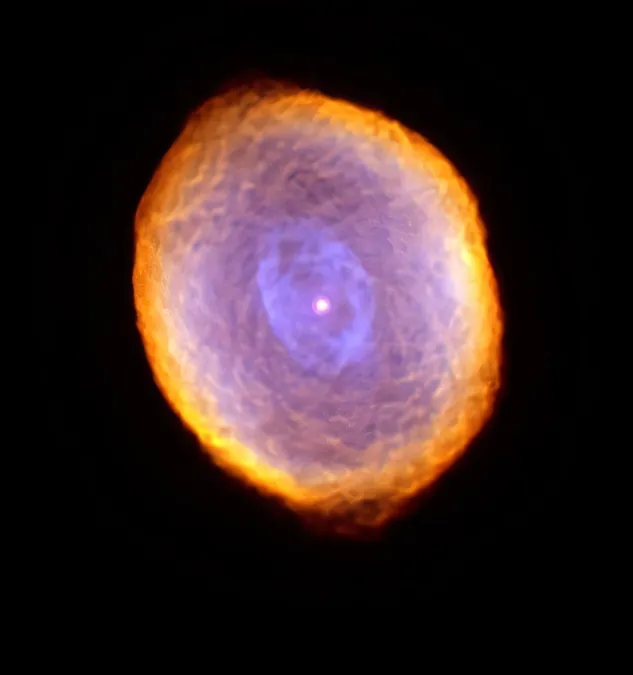
A 130-Year Journey Through Cosmic Transformation: The Fascinating Evolution of Planetary Nebula IC418
2025-09-21
Author: Wei Ling
The Majestic Dance of the Cosmos
While the universe may seem static to the naked eye, there are breathtaking cosmic phenomena that tell a different story. Take the planetary nebula IC418, also whimsically known as the "Spirograph Nebula" for its mesmerizing interwoven loops. Situated in the constellation Lepus, this celestial wonder has captured the attention of astronomers for over a century.
A Landmark Study Unfolds
Researchers from the University of Manchester and Hong Kong University have published groundbreaking findings in the *Astrophysical Journal Letters*, charting the evolution of IC418 over the last 130 years. This study compiles observations that date back to the nebula's discovery in the late 19th century.
History in the Skies: The Discovery of IC418
Discovered on March 26, 1891, by the trailblazing Scottish-American astronomer Williamina Fleming at Harvard Observatory, IC418 was initially part of the Draper Catalog. Known for identifying 59 nebulae through meticulous glass plate analysis, Fleming's contributions have largely shaped our understanding of the night sky.
The Nebula’s Stellar Journey
IC418 shines at a 9th magnitude and spans approximately 2,000 light-years away, with a diameter of about 0.2 light-years. These planetary nebulae, named for their ghostly appearance resembling planetary disks, hold the remnants of dying stars.
Spectroscopic Insights
This study's fascinating aspect lies in its ability to connect over a century of spectroscopic data, tracing changes in IC418’s spectrum from its early observations in the 1890s to modern imaging techniques. "The oldest data we used is from 1893, when the first spectrum was observed by (William W.) Campbell," noted researcher Albert Zijlstra from the University of Manchester.
A Stellar Evolution Story
As a star reaches the end of its lifecycle, it swells into a red giant and begins shedding material into space. The heart of IC418 is currently transitioning into a white dwarf, a stage our Sun is expected to undergo in about five billion years. This evolution provides crucial insights into the lifecycle of materials that create the cosmos.
Unprecedented Temperature Increases
This study revealed that IC418’s central star has increased in temperature by a staggering 3,000 degrees Celsius since its discovery, heating up at an extraordinary pace of about 1,000 degrees every 40 years—significantly faster than any previously observed star.
Crucial Insights into Carbon Production
IC418 is rich in carbon, a cornerstone of life as we know it. The study provided a revised understanding of the star's mass—calculating it to be around 40% more than that of our Sun. This finding may necessitate a reevaluation of theories surrounding carbon-rich stars and their role in enriching the universe with this essential element.
Revisiting Historical Data for Modern Discoveries
This research underscores the lasting value of old astronomical observations. Similar to a past discovery concerning a planetary system around Van Maanen's Star, which was noted on a glass plate from 1917, astronomers are reminded that hidden treasures await discovery in historical data.
Exploring the Cosmos: The Future Awaits
As we unveil the layers of cosmic history wrapped in dust and time, one can't help but wonder what other secrets lie within old glass plates and notebooks. The universe continues to captivate, and each new study sends ripples through our understanding of existence itself.


 Brasil (PT)
Brasil (PT)
 Canada (EN)
Canada (EN)
 Chile (ES)
Chile (ES)
 Česko (CS)
Česko (CS)
 대한민국 (KO)
대한민국 (KO)
 España (ES)
España (ES)
 France (FR)
France (FR)
 Hong Kong (EN)
Hong Kong (EN)
 Italia (IT)
Italia (IT)
 日本 (JA)
日本 (JA)
 Magyarország (HU)
Magyarország (HU)
 Norge (NO)
Norge (NO)
 Polska (PL)
Polska (PL)
 Schweiz (DE)
Schweiz (DE)
 Singapore (EN)
Singapore (EN)
 Sverige (SV)
Sverige (SV)
 Suomi (FI)
Suomi (FI)
 Türkiye (TR)
Türkiye (TR)
 الإمارات العربية المتحدة (AR)
الإمارات العربية المتحدة (AR)